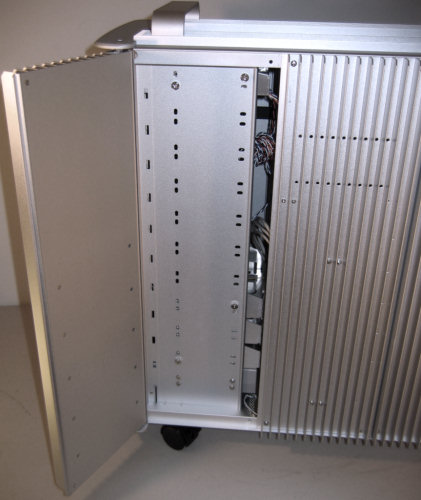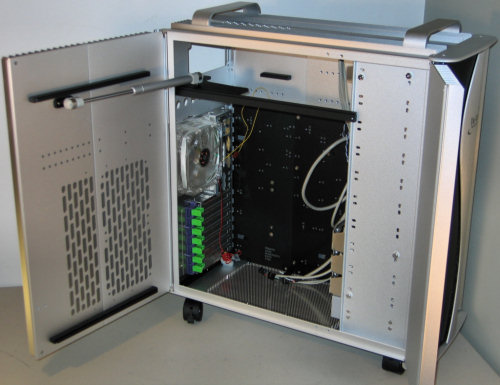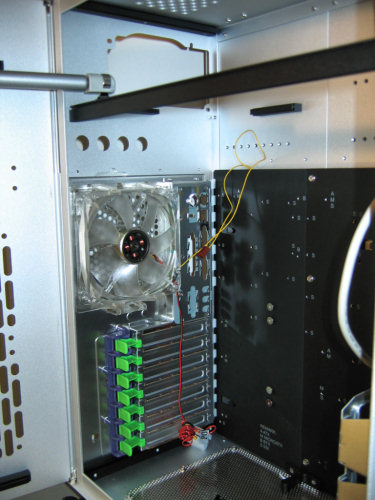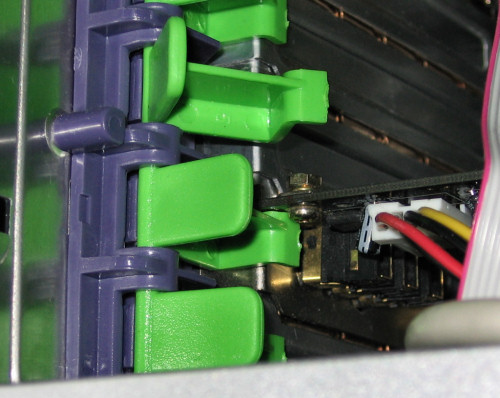Clash of the Titans - TT Tai Chi vs. CM Stacker 830
by Joshua Buss on February 23, 2006 12:05 AM EST- Posted in
- Cases/Cooling/PSUs
Thermaltake Tai Chi (cont’d)
To keep the case as tool-less as possible, Thermaltake simply chose to use thumbscrews to secure drives into the 5¼” bays. While this requires opening the right side of the chassis, there are a couple reasons why this isn't as much of a problem with the Tai Chi as it is with most cases.
First, this area of the case can open entirely on its own as shown in the picture above, which we found that it actually makes for an excellent place to hide additional cables, ensuring tidiness in the rest of the PC. More importantly, however, the Tai Chi's free-turning casters make turning the case a cinch, so access isn't as big of a deal. Two of the same large extended thumbscrews mentioned previously are used to hold this latch secure when closed.
The left side of the case is where the real attraction on the Tai Chi comes though. Here, a hydraulic arm is used to actively swing the oversized access door open, which simply consists of two of the solid passive vent-lined panels connected with the black solid aluminum bars visible in the above picture. The third panel on the left side opens as well, mirroring the panel on the right side that was just discussed.
This active opening mechanism has its own benefits and drawbacks; in using the case, the main advantage to this approach that we've found is that it stays fully open when working inside. Besides that, and the “wow factor“ of showing off the case, there's not much of a reason to incorporate the arm; especially if lots of equipment are installed to the inside of the door, a forceful opening might not be what the user desires. However, if preferred, the entire hydraulic assembly can be removed without hurting any other functionality.
The front of the case is exceptionally accessible, thanks to this dual-door design. Notice how there's another area here between the forward door and the drive bays (about one full inch in width) that could be used for any number of things. This picture is also a decent shot of the bottom mesh and motherboard tray, and also gives one an idea of how neatly they can route the cables from the top-mounted external ports, considering their plentiful length.
Focusing on the inside rear of the case, we find one of the only two main active cooling components, a Thermaltake 120mm blue LED fan. These fans move plenty of air without making enough noise to even really notice that they're on, especially if controlled to use slightly less voltage than the standard 12v.
The punch outs for 3/8” OD water tubing are also visible, as are the same tool-less expansion card locking mechanisms found on the Eclipse, which was recently reviewed by AnandTech. One frustration with this particular scheme is that they can be very difficult to unclip with certain cards. A SoundBlaster Audigy for instance made it darn-near impossible to unclip the green part in our test system due to a bolt on the card as seen here.
We'd prefer here if Thermaltake had simply opted for large thumbscrews like what other manufacturers are doing for the expansion cards. Take comfort though that this is pretty much the only complaint that we have with the Tai Chi after working with it for several days.
The spaces between the PSU area, crossbar, and motherboard assembly are all generous and, combined with the wide-opening dual doors, make working in the case a real pleasure. One last point of interest in this picture is the slots in the motherboard tray near the rear – they're not just at the bottom, indicating yet again that the case is truly designed and ready for BTX motherboards.
To keep the case as tool-less as possible, Thermaltake simply chose to use thumbscrews to secure drives into the 5¼” bays. While this requires opening the right side of the chassis, there are a couple reasons why this isn't as much of a problem with the Tai Chi as it is with most cases.
First, this area of the case can open entirely on its own as shown in the picture above, which we found that it actually makes for an excellent place to hide additional cables, ensuring tidiness in the rest of the PC. More importantly, however, the Tai Chi's free-turning casters make turning the case a cinch, so access isn't as big of a deal. Two of the same large extended thumbscrews mentioned previously are used to hold this latch secure when closed.
The left side of the case is where the real attraction on the Tai Chi comes though. Here, a hydraulic arm is used to actively swing the oversized access door open, which simply consists of two of the solid passive vent-lined panels connected with the black solid aluminum bars visible in the above picture. The third panel on the left side opens as well, mirroring the panel on the right side that was just discussed.
This active opening mechanism has its own benefits and drawbacks; in using the case, the main advantage to this approach that we've found is that it stays fully open when working inside. Besides that, and the “wow factor“ of showing off the case, there's not much of a reason to incorporate the arm; especially if lots of equipment are installed to the inside of the door, a forceful opening might not be what the user desires. However, if preferred, the entire hydraulic assembly can be removed without hurting any other functionality.
The front of the case is exceptionally accessible, thanks to this dual-door design. Notice how there's another area here between the forward door and the drive bays (about one full inch in width) that could be used for any number of things. This picture is also a decent shot of the bottom mesh and motherboard tray, and also gives one an idea of how neatly they can route the cables from the top-mounted external ports, considering their plentiful length.
Focusing on the inside rear of the case, we find one of the only two main active cooling components, a Thermaltake 120mm blue LED fan. These fans move plenty of air without making enough noise to even really notice that they're on, especially if controlled to use slightly less voltage than the standard 12v.
The punch outs for 3/8” OD water tubing are also visible, as are the same tool-less expansion card locking mechanisms found on the Eclipse, which was recently reviewed by AnandTech. One frustration with this particular scheme is that they can be very difficult to unclip with certain cards. A SoundBlaster Audigy for instance made it darn-near impossible to unclip the green part in our test system due to a bolt on the card as seen here.
We'd prefer here if Thermaltake had simply opted for large thumbscrews like what other manufacturers are doing for the expansion cards. Take comfort though that this is pretty much the only complaint that we have with the Tai Chi after working with it for several days.
The spaces between the PSU area, crossbar, and motherboard assembly are all generous and, combined with the wide-opening dual doors, make working in the case a real pleasure. One last point of interest in this picture is the slots in the motherboard tray near the rear – they're not just at the bottom, indicating yet again that the case is truly designed and ready for BTX motherboards.
















55 Comments
View All Comments
tscholz - Sunday, April 30, 2006 - link
As for cooling, these cases are some of the most stupid designs i have ever seen. What are all those meshes doing on the stacker, but ruining the cooling performance. The proper way to cool a case is by using vacuum, and not by sucking or blow huge amounts of air in and out from all directions. A case should have one air intake (might be a few smaller ones), and one output. Only one fan is needed on the output, since it creates the vacuum to suck new air in from the input intake(s).And as for the Tai Chi, no those fancy fans on the sides does not do much (if anything) for the cooling. The energy transfer rate from the air inside to the alu casing is very little, and does not match the effects of fresh air constantly moving through tha case. The only thing these fans will do, is to collect dust.
There is no doubt that the interior of these cases are cool then full of fans, but why use that many when you don't have to?! More fans equal more noise, and does not make it that much cooler.
For reference, my case has a total of 2 fans (3 if you count graphics), one in the PSU, and one in the back that cool CPU and keeps air flowing through the casing. I blocked off all those extra holes in the back and front, to make sure that the air flows past the HD's, over the chipset, through my Thermaltake Tower 112 (damn it's big), and finally blown out the back. At a room temp. at 23 °C, the interior and CPU temp is 32 °C idle (53 °C load).
seanp789 - Saturday, March 18, 2006 - link
alot fo people are wondering if these things really work and there are debates on both sides.I bought the case recently and have come to this conclussion.
A typical heatsink is in direct contact with the heat source. The tai chi case only comes in contact with air for the most part. Now there is no doubt that there is hot air inside your case. The longer your case is running at full load the more of an effect that hot air has on surrounding components. While its true that air is less conductive that a directly contact, the massive surface area the case provides as a heatsink is what allows it to be so effective.
For doubters, take this simple test I did. Use a blow dryer to heat the side of your case, then use a blow dryer on the tai chi case. you will find that the tai chi cools itself much faster than a normal case. While i didnt take exact temps I timed the dryer exposure time and relatively how long each case took to cool.
chynn - Thursday, March 2, 2006 - link
After you can mount an ATX motherboard in the motherboard tray, you can use either the left (normal) or right (inverted) case slots to insert the tray.You can relocate the four fan array to either side of the case.
You can change the side the front door is mounted to, which is great for left-handed people like me.
You have to screw down all components mounted in the 5.25in bays with the provided screws. The snap locks are there only for positioning and/or testing purposes.
The stock fans are noisy, sleeve bearing, and low MTBF units. Not good for this costly a case. OTOH, the fans in the ThermalTake might be just as bad ... :)
JoshuaBuss - Monday, May 15, 2006 - link
Actually the front door can't be turned upside down so that it opens the other way. I tried.. it doesn't fit.The snap locks work fine for permanent mounting...?
The stock fans I received are VERY quiet, even at 12v.
fsardis - Thursday, March 2, 2006 - link
do you even own the case? have you even heard the fans? FYI they are both inaudible and i speak from first hand experience cause i own the thing.just because it has a sleeve bearing doesnt mean its noisy.
Systemshocked - Wednesday, March 1, 2006 - link
I purchased an Armor case last year, and my one gripe about the case is the tool-less expansion card clamp (that green and purple thing in Anandtech's photos). It's flimsy, and it didn't fit with my Geforce 6800 GT video cards. So I removed it.So much worthless processed hydrocarbon in my opinion.
And I wouldn't trust it to hold my cards in place if you're planning on transporting the case anywhere.
My two cents.
seanp789 - Monday, February 27, 2006 - link
the specs measure the tai chi at 600mm or a little less than 2 feet. I woudl like to if height is measured with or without wheels and handles. because the clearance below my desk is right on the borderline and im afraid the handles will make it not fit.r33tr33t - Sunday, February 26, 2006 - link
Why doesn't AnandTech review the Zalman Totally No Noise Series?The TNN 500AF is more expensive than either of these cases and probably has competitive build quality.
Aikouka - Sunday, February 26, 2006 - link
I was wondering if you'd use some possible higher enthusiast (or just tests for plain looney people). What I mean by this is for example, I am in the market for a new case right now, because I currently have 5 HDDs in my Xaser III V2000A. I built a computer for a friend with a 7800GT SLi configuration and both of his video cards run 20C cooler than my single 6800GT (both being BFG OC cards). His 4800+ runs cooler than my 4400+ and I use a Thermalright XP90C with Arctic Silver V where he used the stuff that came in the box. So, yeah... thermals are why my games sometimes will mess up, but I'm not sure what cases are a good choice.Like I said, it's kind of leaning toward enthusiast/looney to do tests where you up the thermal anty, but there are people with multiple hard drives in their machines and for people in predicaments like mine (where their hard drives sit in front of their only intake fans), they're in quite the pickle.
chynn - Thursday, March 2, 2006 - link
So what case are you using, friend??? It would help if we knew ... :)For example, one of the reasons I am moving to the RC-830 is that my Lian-Li V1200 case does not cool the SLI graphics cards properly, so the whole case runs hot.
I have purchased the V1200 "Plus" cooling kit and some 120mm Scythe SFF21F fans though to remedy that problem.
The Lian-Li has an Asus A8N-SLI Deluxe, FX-55, 2x eVGA 6800GT 256M, 2x 74G WD Raptors and a hard drive in it.
The RC-830 will have a DFI LanParty UT Expert, FX-60, 2xeVGA 7800GTX ACS3, 2x 150G WD Raptors and a hard drive in it.
Both cases have a DVD reader/burner and a floppy drive in them.
From looking at the two cases, the RC-830 has the better cooling solution by far ... even after the Plus kit is installed in the Lian-Li.